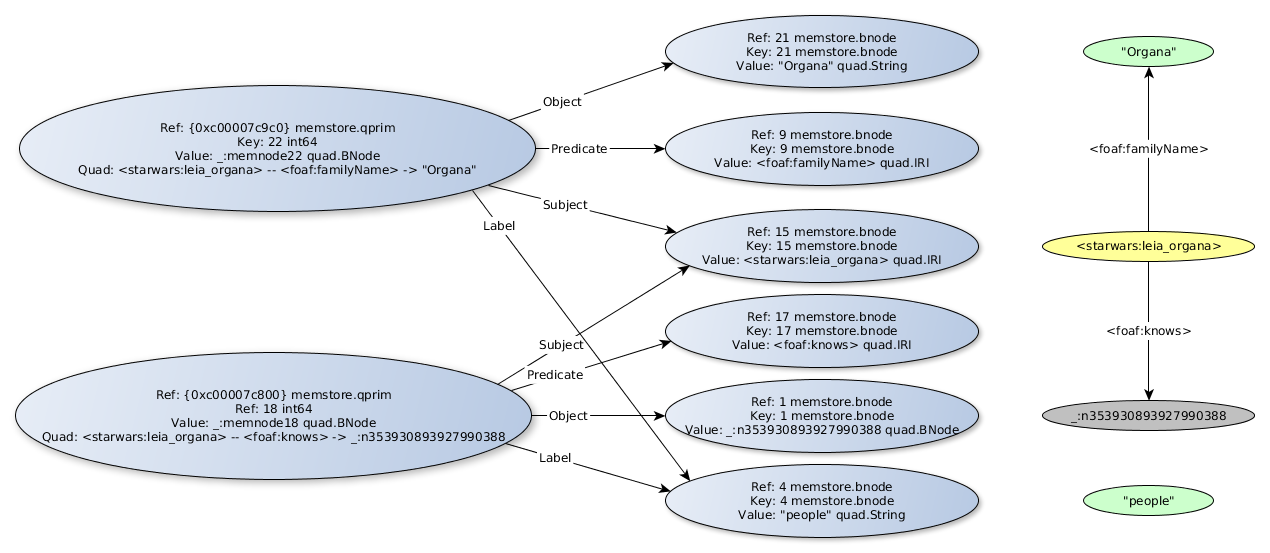Statements #
Subject, Predicate Object #
We use statements of facts to define knowledge. In general, we usually use declarative sentences to make statements of facts.
For example:
Luke Skywalker is 23 years old.
or, in other words:
Luke Skywalker has age 23.
It is possible to convert these declarative sentences into a subject-predicate-object structure.
Luke-Skywalker has-age 23.
The parts of this sentence:
- subject:
Luke-Skywalker, - predicate:
has-age, - object:
23.
As there may many Luke Skywalker exist in our World, therefor we will use the Luke-Skywalker-from-StarWars identifier to the specific person, that is the subject/object of our discussion.
We want to use this universal ID in standard format, so Luke’s ID will be the following IRI: <Luke-Skywalker-from-StarWars>.
Luke is a resource, or entity in other words, that we can obviously identify by an IRI.
He has the age property, that we can can express by the <has-age> IRI, since this is a generic term. In addition, we need a literal value, that is 23, with the type of integer. This is the value that belongs to the <has-age> property, in case of Luke.
The final statement looks like this:
<Luke-Skywalker-from-StarWars> <has-age> 23^^integer .
We can observe on the Figure 1. that the subject-predicate-object triple can be visualized as a simple graph, where the subject and object show up as nodes, and the predicate appears as a labeled edge between these two nodes.

Figure 1.: Subject-Predicate-Object Graph
The statements written in this form mentioned above are also called triples.
Let’s see how could we define for the computer the following facts:
Luke Skywalker is a person in the StarWars Universe.
His family name is Skywalker, and his given name is Luke.
Luke is 23 years old.
Leia Organa is a person in the StarWars Universe.
Her family name is Organa, and her first name is Leia.
Leia knows Luke.
Let’s transform the sentences listed above to the subject-predicate-object format, using IRIs for the predicates:
<Luke-Skywalker-from-StarWars> <is-a> <Person> .
<Luke-Skywalker-from-StarWars> <has-given-name> "Luke" .
<Luke-Skywalker-from-StarWars> <has-family-name> "Skywalker" .
<Luke-Skywalker-from-StarWars> <has-age> 23 .
<Leia-Organa-from-StarWars> <is-a> <Person> .
<Leia-Organa-from-StarWars> <has-given-name> "Leia" .
<Leia-Organa-from-StarWars> <has-family-name> "Organa" .
<Leia-Organa-from-StarWars> <knows> <Luke-Skywalker-from-StarWars> .
These statements will be visualized as graph, including the resources, predicates and literals we have just introduced.
The resources (subjects and objects):
- Luke Skywalker in the StarWars Universe:
<Luke-Skywalker-from-StarWars>, - Leia Organa in the StarWars Universe:
<Leia-Organa-from-StarWars>, - Person (as concept):
<Person>.
The predicates:
<is-a>,<has-given-name>,<has-family-name>,<has-age>,<knows>.
The literals:
"Luke","Skywalker","Leia","Organa",23.
The Figure 2. demonstrates how the statements listed above appear as graph:

Figure 2.: Predicates represented as graph
The entities appear in yellow color, and the literals are drawn in green color.
Blank Nodes #
Often, when we define the knowledge, we do not want to use IRIs for identification with global scope, only with scope internal to the given graph, or source file, that holds the statements. In these cases, we only need to be able to express somehow that which subject and object are connected to each other via a predicate, so it is enough to use an internal ID, that can be auto-generated, and even a hidden one. These nodes are called Blank Nodes.
A Blank Node also has a unique identifier, that has internal scope only for the actual graph, that is valid until the program is running.
The name of Blank nodes begin with the _:, that is followed by some (randomly-generated) alpha-numeric string.
The Figure 3. shows a graph, that is very similar to the one on Figure 2., but in this latter case the two persons are not identified by global IRIs, but by Blank nodes with local scope.

Figure 3.: Predicates represented as graph, using Blank nodes
The Blank Nodes appear in gray color.
Related pages:
The internal representation of nodes and quads #
It is important to note that internally, the predicates are also represented in the form of graph nodes, such as IRIs or even as Literal values too. They can appear in the results of queries too. The Figure 4. shows how the internal representation looks like (left side), compared to the diagram notation we’ve been using so far (right side).
The diagram visualizes the following two quads:
<starwars:leia_organa> <foaf:familyName> "Organa" "people" .
<starwars:leia_organa> <foaf:knows> _:n353930893927990388 "people" .

Figure 4.: The internal representation of quads.
We can do the following observations on the internal representation:
- The subjects and objects (IRIs and Blank nodes) and the literal values are all represented as graph nodes,
- The predicates are also represented as graph nodes,
- The graph labels are also represented as graph nodes,
- The elements of a complete n-quad statement are represented by an additional graph node.